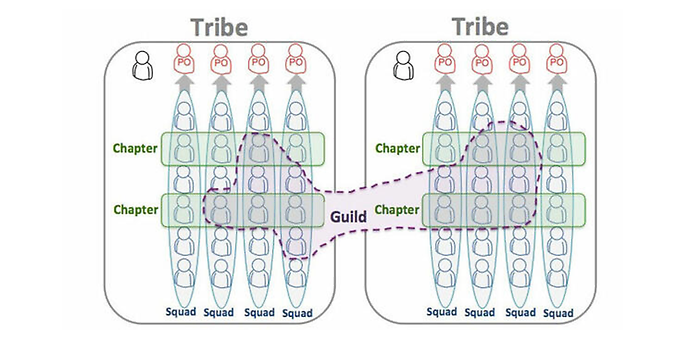17. June 2024 By Siver Rajab
The Spotify Scrum model compared to classic Scrum in companies
In the world of agile software development, there are various approaches to help teams work together efficiently and deliver high-quality products. Two popular models are the classic Scrum and the Spotify model. Both provide a framework for agile working methods, but differ in their organisational structure, scalability and flexibility. In this blog post, I will highlight the differences between the two approaches and analyse their respective advantages and disadvantages.
Classic Scrum: a proven framework for agile development teams
Classic Scrum is an iterative and incremental framework for agile software development. It consists of clearly defined roles such as the Product Owner, the Scrum Master and the development team, artefacts such as the Product Backlog and the Sprint Backlog as well as various events such as Sprint Planning, the Daily Scrum, the Sprint Review and the Sprint Retrospective. This structured model provides teams with a clear guideline for organising their work and continuously creating value.
The Spotify model: an alternative approach to scalable agility
The Spotify model was developed by Henrik Kniberg and Anders Ivarsson and is an alternative to classic Scrum that is particularly suitable for larger organisations. It is based on the idea of "tribes", "squads", "chapters" and "guilds", which organise teams in a hierarchical structure. Each team works autonomously in a specific area and is simultaneously part of a larger network that promotes collaboration and knowledge sharing.

Das Spotify-Modell, Quelle: https://www.projektmagazin.de/artikel/spotify-modell-projektorganisation
Differences between the Spotify model and classic Scrum
1. Organisational structure
While classic Scrum focuses on the organisation of individual development teams, the Spotify model emphasises a hierarchical structure of tribes, squads, chapters and guilds, which enables better collaboration across team boundaries.
2. Scalability
The Spotify model is designed to scale agility at an enterprise level, whereas traditional Scrum is more suitable for small to medium-sized teams.
3. Flexibility
The Spotify model allows organisations to adapt their way of working to their specific needs by configuring elements such as tribes and squads as required. Classic Scrum, on the other hand, is less flexible and offers a fixed structure.
Advantages and disadvantages of the Spotify model compared to classic Scrum
Advantages of the Spotify model:
- 1. Scalability: the Spotify model enables organisations to achieve enterprise-level agility by providing a flexible structure that allows teams to collaborate effectively and manage large projects.
- 2. Fostering collaboration: By organising teams into tribes and squads, the Spotify model encourages collaboration and knowledge sharing, leading to higher productivity and quality.
- 3. Adaptability: The Spotify model enables companies to adapt their way of working to their needs by allowing them to flexibly design the structure and organisation of their teams.
Disadvantages of the Spotify model:
- 1. Complexity: the introduction and implementation of the Spotify model requires careful planning and potentially far-reaching organisational changes, which can lead to increased complexity.
- 2. Risk of fragmentation: In larger organisations, there is a risk that the Spotify model could lead to fragmentation if collaboration between the different tribes and squads is not effectively coordinated.
- 3. Scaling challenges: Although the Spotify model is scalable, companies may encounter challenges when trying to implement and scale the model in larger organisations.
Conclusion
Both approaches, classic Scrum and the Spotify model, offer different advantages and disadvantages that organisations should consider when deciding whether to introduce agile methods. While classic Scrum offers a proven structure for small to medium-sized teams, the Spotify model enables a scalable and flexible way of working that allows organisations to achieve agility at an enterprise level. Ultimately, the choice of the appropriate model depends on the specific requirements and goals of the organisation.
Would you like to find out more about exciting topics from the world of adesso? Then take a look at our previous blog posts.
